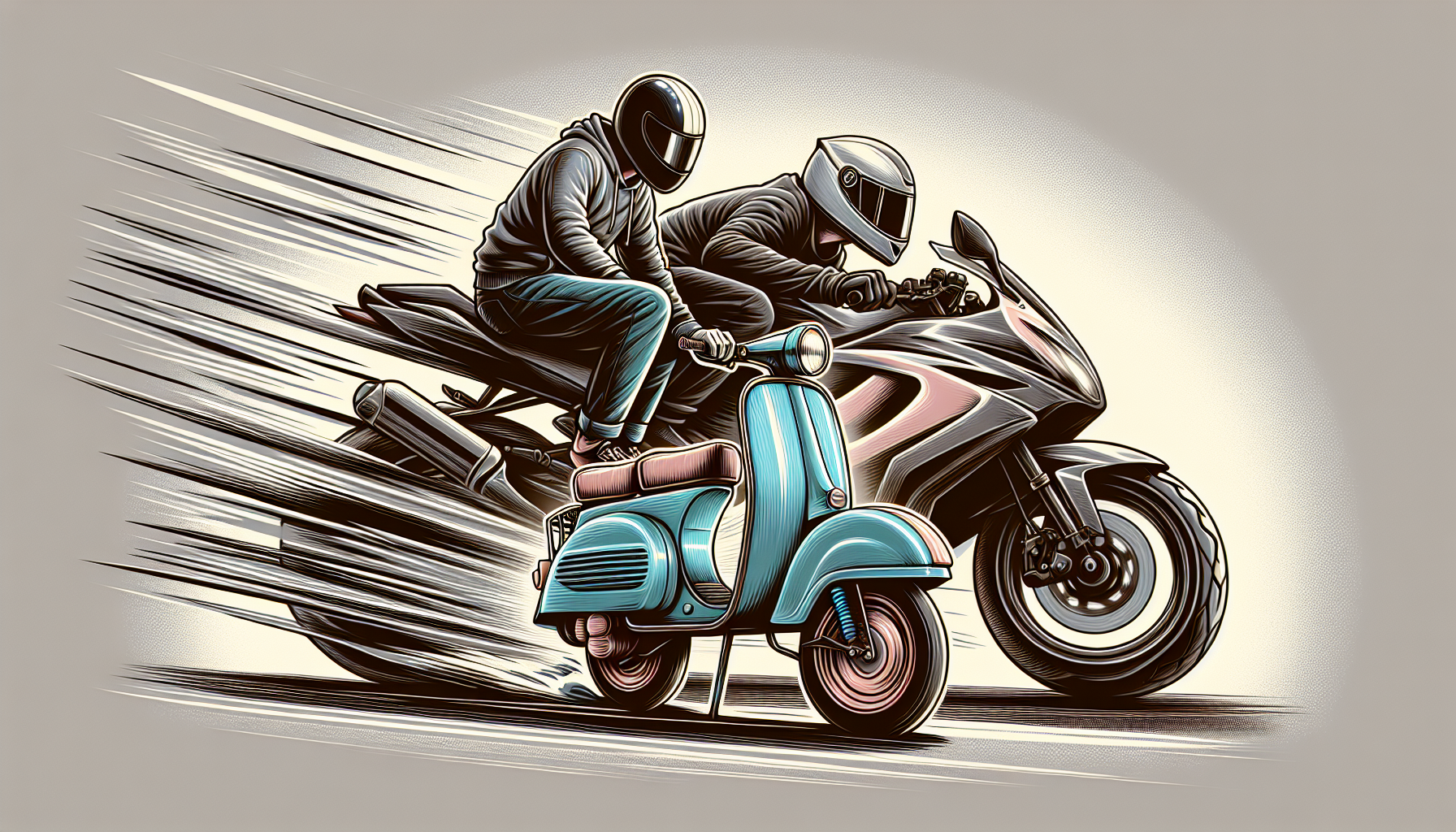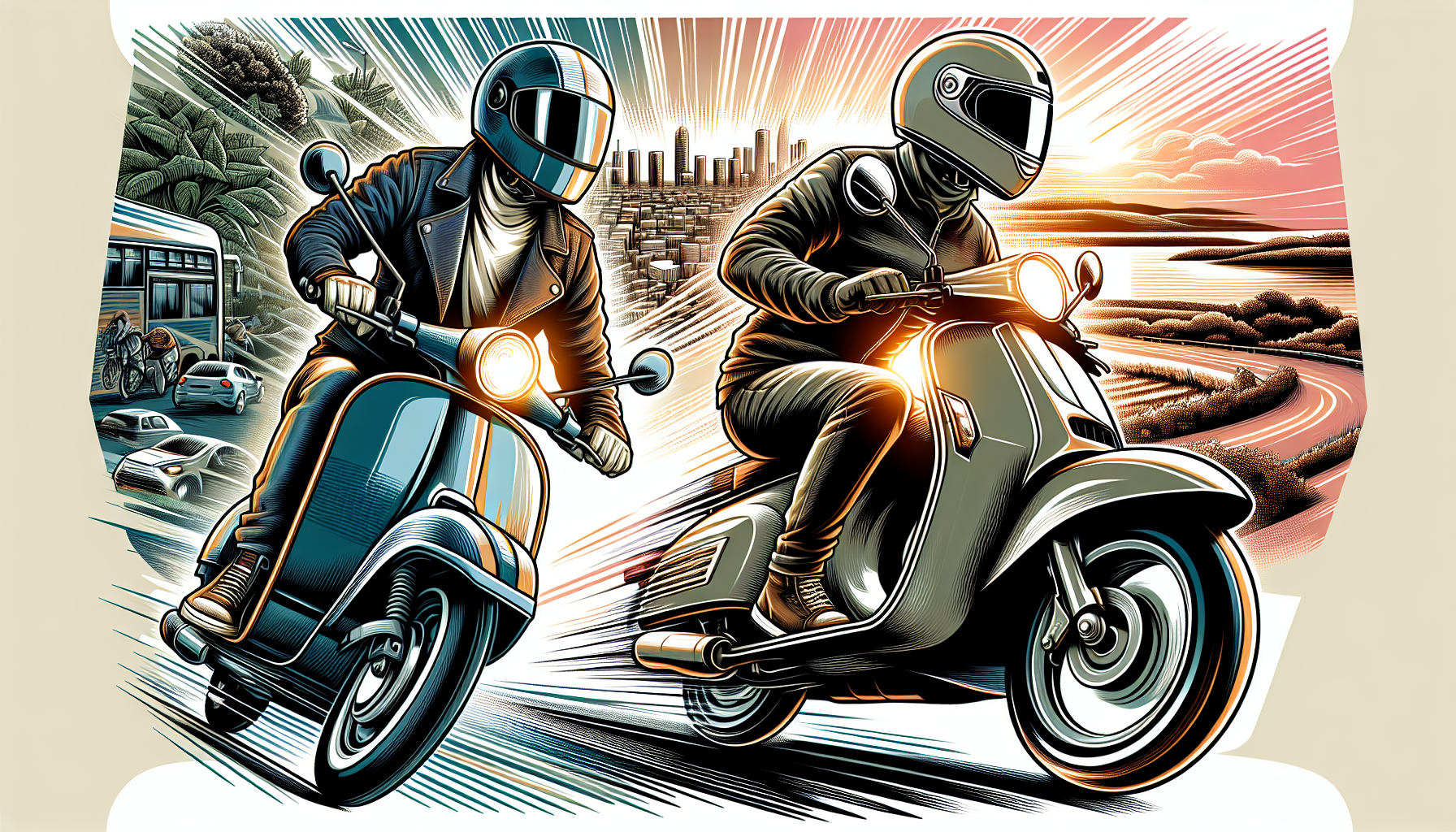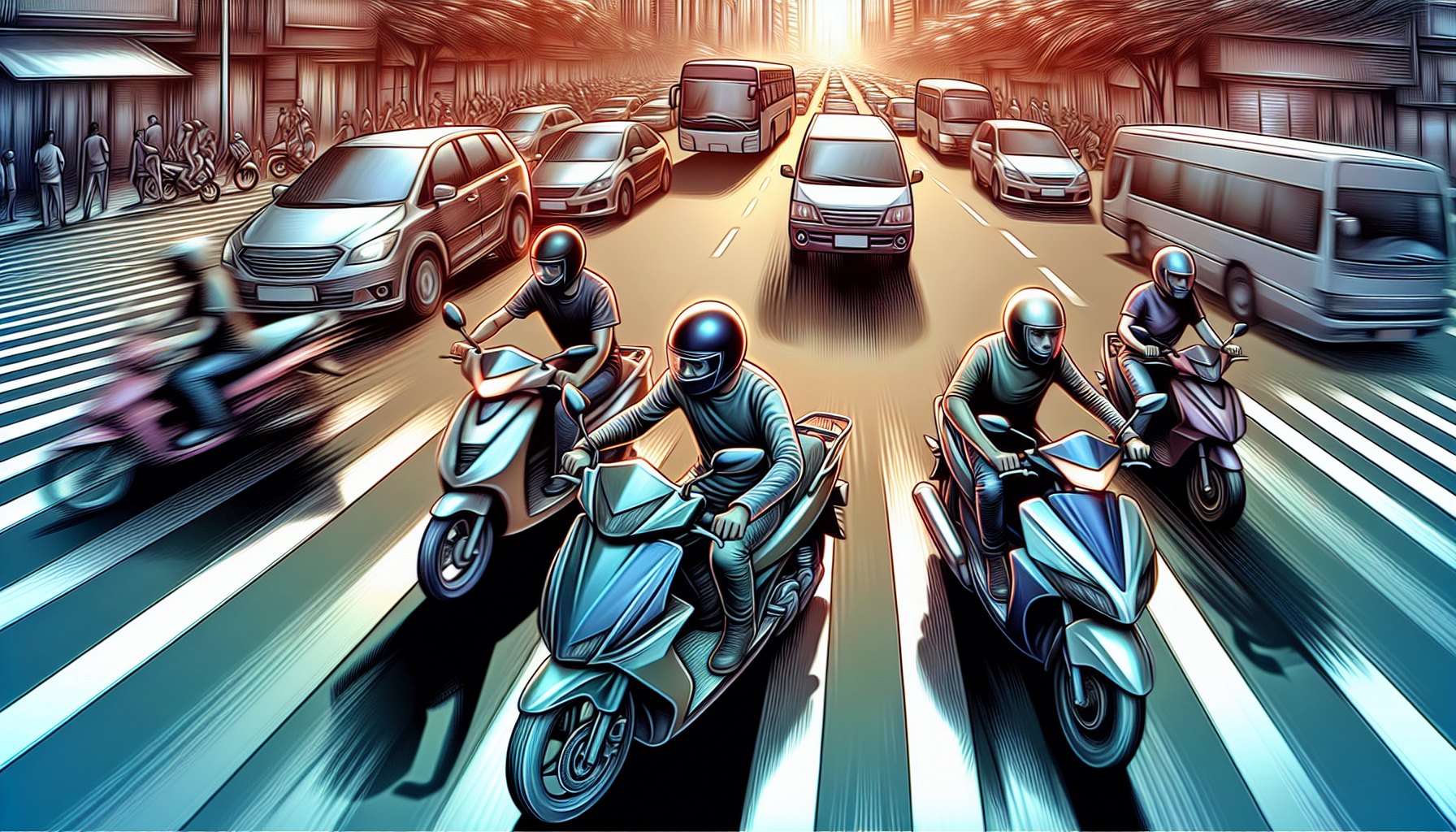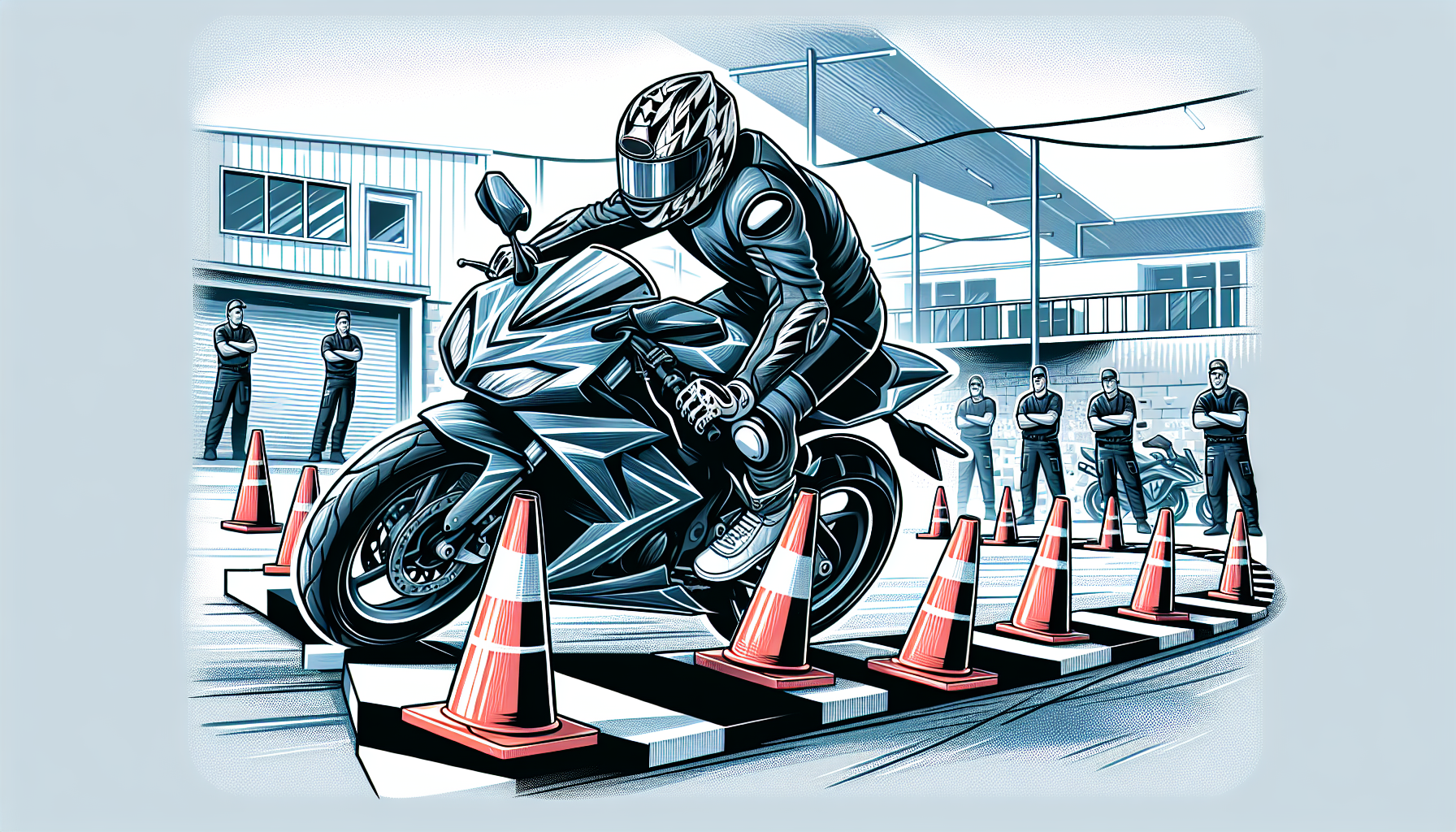When choosing between a moped and a motorcycle, understanding “which is more dangerous: mopeds or motorcycles?” is key. Mopeds have higher crash rates, but motorcycles lead in crash severity. Our exploration provides a direct comparison to inform your two-wheeled travels with safety as the priority.
Key Takeaways
Moped riders experience a higher crash rate compared to motorcyclists, though motorcycle accidents tend to be more severe, especially at higher speeds and during night or weekends.
Safety gear, notably helmets that meet DOT or equivalent standards, is critical for reducing injury severity in accidents for both moped and motorcycle riders, with protective clothing providing additional defense.
Rider safety is not only a matter of personal gear but also extends to legal compliance, including licensing requirements and traffic rules, and proper training to navigate and maneuver in traffic safely.
Analyzing the Risk: Mopeds vs. Motorcycles

As we delve into the dangerous world of two-wheelers, it’s essential to understand the risks associated with these vehicles. Moped riders face a higher crash rate, nearly four times higher than motorcyclists safer than motorcycles do, based on distance traveled. Shocking, isn’t it? Scooter crashes, although not as frequent as moped incidents, are still a concern for scooter riders and should be taken into account.
However, this doesn’t make motorcycles any more safer than motorcycles. When you look at the severity of motorcycle crashes though, motorcycles take the lead, especially in:
high-speed zones
weekends
nighttime
single-vehicle incidents
The risks are undeniably higher for motorcycle riders due to greater exposure, making strict adherence to traffic regulations crucial for their safety.
Understanding Crash Dynamics
The dynamics of crashes vary significantly between mopeds, bikes, scooters and motorcycles, primarily due to their design and speed. Did you know that speed is a major factor in the severity of crashes? It’s true; higher speeds generally result in more serious crashes.
Motorcycles, designed for higher speeds and less stability, travel faster than mopeds. This means that in the event of a crash, the energy involved is greater, leading to a higher potential for severe injuries. Design differences between bikes and motorcycles, such as size and protective structures, also play a significant role in influencing the risk and severity of injuries in an accident.
Accident Research Insights
Diving deeper into accident research, it’s clear that motorcycle crash severity tends to be higher than moped crash severity in general. Factors such as:
higher speed limits exceeding 80 km/h
horizontal curves
weekend occurrences
single-vehicle incidents
nighttime driving
are associated with increased serious motorcycle crashes and crash severity.
Conversely, moped crashes, while generally less severe compared to moped crashes or to motorcycles, increase in severity at night and in speed zones of 90 km/h or more. These insights underline the need for proper safety measures and adherence to traffic rules when riding a moped or either vehicle.
Safety Gear: Mopeds vs. Motorcycles

A crucial aspect of road safety for two-wheeler scooter riders, is wearing appropriate safety gear. Unlike passenger vehicles, mopeds and motorcycles lack protective frames, seatbelts, airbags, and other safety features. This absence of built-in safety features makes the use of appropriate safety gear critical for rider protection.
Helmets are the most crucial piece of proper safety gear for riders. They can significantly mitigate head injuries during accidents. Protective clothing, such as:
jackets
pants
gloves
boots
Seat belts can prevent or reduce lacerations, fractures, and other serious injuries, in the event of an accident. Remember, being prepared and protected can be a lifesaver on the road.
Helmet Safety Standards
When it comes to head protection, not all helmets are created equal. Helmets that meet the U.S. Department of Transportation (DOT) certification are compliant with the Federal Motor Vehicle Safety Standard (FMVSS) No. 218. This label signifies a helmet’s reliability during a crash.
DOT-certified helmets typically weigh around 3 pounds and feature sturdy chin straps with solid rivets. Unsafe helmets often lack the necessary structural integrity, with less than 1 inch of protective padding, weak fastening systems, and may present features such as elongated decorations that are not permitted under DOT regulations.
Globally, helmets must also adhere to standards such as the British Standard BS 6658:1985 with the BSI Kitemark and UNECE Regulation 22.05.
The Impact of Protective Clothing
Moving beyond helmets, let’s talk about protective clothing. This gear can defend against bone fractures, lacerations, and bruises, which make up a significant portion of injuries from bike and moped accidents.
Materials like leather and Kevlar in motorcycle clothing serve as a barrier against abrasion, helping to minimize road rash, cuts, and bruises in the event of a crash. Full coverage for limbs with heavy-duty materials like leather or heavy denim provides optimal protection. Visibility can also be enhanced by wearing brightly colored clothing with reflective materials and keeping headlights on. Safety courses emphasize the proper use of motorcycle gear, which is critical in reducing the likelihood of severe injuries.
Some key points to remember about motorcycle clothing:
Use materials like leather and Kevlar for optimal protection against abrasion.
Choose clothing that provides full coverage for limbs.
Wear brightly colored clothing with reflective materials to enhance visibility.
Keep headlights on for increased visibility.
Take safety courses to learn how to properly use motorcycle gear and reduce the risk of severe injuries.
Legalities and Licensing
Having your ride isn’t just about hopping on and revving the engine; it also involves understanding and adhering to legalities and licensing requirements. For example, motorcycles with engines larger than 150 cc require a specific motorcycle license to operate in California.
Whether you’re a moped or motorcycle rider, understanding the licensing requirements is key to ensuring you’re operating your vehicle legally and maintaining safety standards. Let’s delve deeper into what these requirements entail.
Written Exam and Road Tests
To legally operate a moped in California, you must obtain a motorcycle license (M1 or M2) and must be at least 16 years old. Motor-driven cycles with an engine size smaller than 149 cc in California require registration and an M1 motorcycle license for operation.
The process of obtaining a license involves passing a written exam and road tests. By meeting these requirements, you not only stay on the right side of the law but also ensure that you have the necessary skills and knowledge to operate your two-wheeler safely and efficiently.
Traffic Rule Compliance
Besides obtaining the right license, you must also comply with traffic rules. Observing traffic signals, stop lights, and speed limits is essential for the safety of motorcyclists and to avoid legal issues.
Practicing responsible riding by obeying traffic laws, staying within speed limits, and maintaining a safe distance from other vehicles is highly recommended. In California, motorized scooters are limited to operations on bicycle paths, trails, or bikeways and cannot be driven on sidewalks, with a speed not exceeding 15 mph.
Motorcycle safety courses provide traffic law education to help riders avoid accidents by teaching correct lane positioning, passing techniques, and rules for lane sharing and safe turning.
Maneuvering Through Traffic: Mopeds vs. Motorcycles

Riding a moped or motorcycle isn’t merely about managing the vehicle itself; it’s also about managing the space around you. Effectively maneuvering through traffic requires riders to maintain awareness of other drivers’ actions and blind spots.
Whether it’s lane changing, overtaking, or just riding in straight lines, being aware of other vehicles around you is important. A key skill taught in safety training programs is scanning the road and maintaining awareness of the actions of other drivers, which is vital for avoiding potential blind spot accidents and navigating safely through traffic.
Navigating Blind Spots
Did you know that due to their size and quietness, mopeds are very hard to see when they are in a driver’s blind spot? Motorcycles and mopeds also commonly fall into blind spots beside and slightly behind the rider, where they are not visible to drivers of larger vehicles.
Staying visible is crucial to avoid accidents. Riders can achieve this by:
Positioning themselves where they can see the driver’s face in the rearview mirror of the vehicle ahead
Choosing to ride ahead of or behind larger vehicles rather than in parallel to minimize time in blind spots
Keeping at least a 20-foot buffer zone between a motorcycle and other vehicles on the road to reduce the risk of being in a blind spot for a prolonged time.
Sharing the Road with Larger Vehicles
Sharing the road with larger vehicles can be a daunting task for any driver of any two-wheeler rider. Larger vehicles have larger blind spots and take longer to stop, making the driver make it crucial for riders to maintain a safe distance and stay visible at all times.
Motorcycle safety courses teach riders defensive driving skills, such as hazard anticipation and obstacle avoidance, which are invaluable when sharing the road with larger vehicles. So, the next time you’re on the road, remember to be aware of the blind spots of nearby vehicles and try to remain out of these areas as much as possible.
Economic Impact of Accidents
Motorcycle accidents have a significant economic impact. In 2010, motorcycle accidents incurred direct economic costs estimated around $16 billion, which cover both aspects that can be directly measured and indirectly measured.
The broader impact of these accidents includes not only the direct costs but expands to societal harm, which was valued at approximately $107.1 billion. These figures underline the importance of safe riding practices and strict adherence to traffic laws.
Medical Expenses After an Accident
Motorcycle accidents can lead to the following expenses:
Immediate medical costs, including doctor visits, hospital tests, surgery costs, and prescription medications
Ongoing treatment, sometimes continuing for months or years
Potential long-term disabilities
These expenses can have a significant impact on the financial well-being of the individuals involved in the accident, especially those who suffer serious injuries.
Therefore, it’s crucial to consider these potential costs when deciding to ride a motorcycle or moped. Settlement amounts post-accident are generally influenced by the severity of injuries sustained, with serious damages resulting in:
higher medical costs over time
potential loss of income
rehabilitation expenses
property damage costs
legal fees
It’s important to weigh these potential costs against the benefits and enjoyment of riding motor scooters, motorcycles, or mopeds.
Compensation for Lost Wages
Aside from the medical bills and expenses, victims of motorcycle accidents may also face financial hardship due to lost wages from missed work. Compensation calculations for lost wages include hours missed at work, hourly rates, and an estimation of lost bonuses or commissions.
If an accident affects a victim’s ability to continue in their profession, compensation can be claimed for future lost earning potential. Settlements for motorcycle accident victims take into account both immediate lost wages and potential future earning capacity.
Road Safety Tips for Two-Wheeler Riders

To conclude, let’s take a moment to reinforce some critical road safety tips for two-wheeler riders. Remember, safety begins with you. Helmets are the only legally mandated protective gear for two-wheeler riders. However, using a helmet and additional specialized gear like gloves, boots, and protective garments can significantly reduce injury severity during accidents.
Due to their smaller size, motorcyclists can be less visible to other drivers, especially while downshifting or weaving. Therefore, moped riders should take extra precautions to ensure they are seen during maneuvers. Moped riders, in particular, are encouraged to:
Wear a helmet
Use reflectors and bright clothing to increase visibility
Ride defensively
Respect the scooter’s speed limits
These measures can help increase safety on the road.
Speed Management and Control
One of the most important safety measures for any rider is mastering speed management and control. Reducing speed can significantly lower speed and prevent traffic crashes. It’s crucial for motorcyclists to slow down, take their time, and maintain control.
Speeding not only increases the likelihood of accidents but also the severity of injuries in case of a crash. Therefore, it’s always safer to ride your bike within speed limits and maintain a safe distance from other vehicles, ensuring you’re traveling at the same speed.
Importance of Rider Training
Rider training is another vital aspect of ensuring road safety. Motorcycle safety courses significantly improve a rider’s skills in controlling and balancing the bike, which is especially beneficial at higher speeds and in situations requiring agile maneuvering.
In addition to handling the vehicle, training also focuses on proper braking techniques and cornering, which are critical for accident avoidance and managing emergency situations effectively. In the end, motorcycle safety courses aim to increase rider confidence, leading to more disciplined and safer riding practices on public roads.
Summary
Whether you’re a moped rider, scooter riders, motorcyclists, or a motorcycle enthusiast, understanding the risks, wearing the right safety gear, observing traffic rules, and receiving proper training are the cornerstones of safe riding. From the thrill of the ride to the potential dangers and economic impacts of accidents, we’ve covered a broad spectrum of topics that underline the importance of safety when riding a two-wheeler.
We hope this comprehensive guide has provided you with valuable insights and safety tips to ensure your rides are as safe as they are enjoyable. Remember, the road is shared, and safety is everyone’s responsibility. So, gear up, ride safe, and enjoy the journey!
Frequently Asked Questions
What are the risks associated with riding mopeds and motorcycles?
Riding mopeds and motorcycles pose different risks, with higher crash rates for mopeds and more severe crashes for motorcycles, especially dangerous when ridden in high-speed zones and during certain times. Be cautious when riding and be aware of these potential risks.
What safety gear is recommended for two-wheeler riders?
Wearing a helmet is the most crucial safety gear for two-wheeler riders, and additional protective clothing like jackets, pants, gloves, and boots can also help prevent or reduce injuries during accidents. So, it’s important to invest in these safety gear to ensure protection.
What licenses are required to ride a moped or motorcycle?
In California, to ride a moped or motorcycle, you need to obtain a motorcycle license (M1 or M2) for both vehicles.
What are some tips for maneuvering through traffic safely?
To maneuver through traffic safely, it’s important to maintain awareness of other drivers’ actions and blind spots, stay visible, position yourself where the driver’s face is visible in the rearview mirror, and keep a safe distance from larger vehicles. These precautions can help prevent accidents.
What are the economic impacts of motorcycle accidents?
Motorcycle accidents can have significant economic costs, including immediate medical expenses, ongoing medical bills and treatment, and lost wages. These accidents can also have broader societal impacts.

